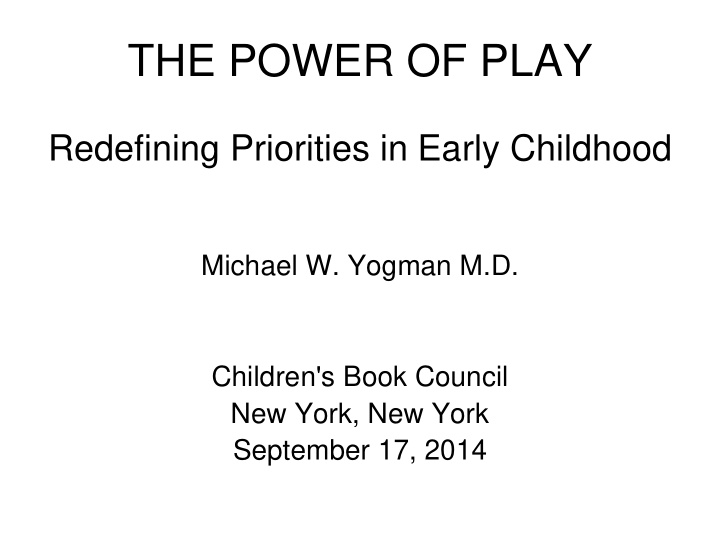



THE POWER OF PLAY Redefining Priorities in Early Childhood Michael W. Yogman M.D. Children's Book Council New York, New York September 17, 2014
• Play is brain building • Play facilitates the normal developmental progression from dependency to independence • Pre-school curricula must emphasize informal, play-based learning • Adult success is enhanced by play in childhood
TECHNOLOGY READING PLAY
WHAT IS PLAY? Enjoyable No Extrinsic Goals Voluntary Active Engagement Brain Building Business of Childhood Development of Executive Function
SUMMARY Development results from an on-going, re-iterative, and cumulative dance between nurture and nature Experience Protective and Personal (versus Insecure and Impersonal) Brain Development Epigenetic Changes Alterations in Brain Alterations in the Way the Structure and Function Genetic Program is Read Behavior Adaptive or Healthy Coping Skills (vs. Maladaptive or Unhealthy Coping)
Out of Balance? Prefrontal Cortex Amygdala Col Cold Cognition Hot ot Cognition Judgme mental Emotio ional Refle lectiv ive Reactiv ive Calc lcula ulatin ing Impuls lsiv ive Thi hink k abou bout i it Ju Just t do i do it Biological maturity by 24 24 Biological maturity by 18 18 Adapted from Ken Winters, Ph.D.
• Attunement • Hands-On Play • Physical Play • Imaginary Play and Storytelling • Guided Play
Attunement
Hands-on Play
Physical Rough and Tumble Play
Imaginary Play
Guided Group Play
Fostering Self-Regulation • Tools of the Mind — Mature make-believe play — Planning play — Teacher scaffolding — Peer interactions; buddy reading, doing and checking — Use of mediators — Self-regulation games
Disparities in Early Vocabulary Growth Professional 1200 Families 1,116 words 1000 Working Class Vocabulary Size 800 Families 749 words 600 Welfare 400 Families 525 words 200 0 9 12 15 18 21 24 27 30 33 36 Age of child in months Source: Hart, B. and Risley, T. R. (2003). “The Early Catastrophe: The 30 Million Word Gap by Age 3.”
Promoting the Five R’s of Early Childhood Education • READING together - daily • RHYMING, playing and cuddling • ROUTINES – help children know what to expect of us - what is expected of them • REWARDS for everyday successes – PRAISE is a powerful reward • RELATIONSHIPS, reciprocal and nurturing- foundation of healthy child development
CREATIVITY INNOVATION COLLABORATION
U US Spending on Early Childhood
Perry Preschool and Abecedarian Projects: An Update Improved behavior/psychological functioning in Perry treatment group, associated with lower arrest, incarceration rates among males (Am Econ Rev, 2013) Lower rate of teen pregnancy, higher educational and employment status Follow up at age 30: substantially lower blood pressure , lower rates of metabolic syndrome (Abecedarian study, Science, 2014)
Public Investment in Children by Age
Heckman Equation Annual return on investment in early childhood: 7-10% (Heckman et al.)
Building an Enhanced Theory of Change that Balances Enrichm ent and Protection New Protective Interventions Significant Adversity Healthy Developmental Trajectory Supportive Relationships, Stimulating Experiences, and Health-Promoting Environments
PLAY • MOMA: Century of the Child, 1900-2000 Play is to the 21 st century what work was to industrialization; it demonstrates a way of knowing, doing and creating value.
Recommend
More recommend